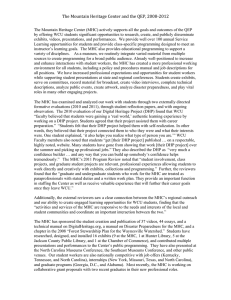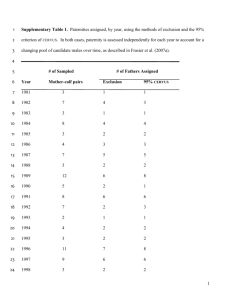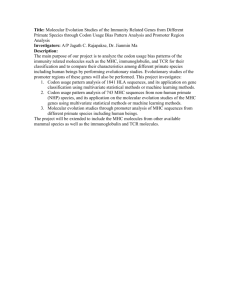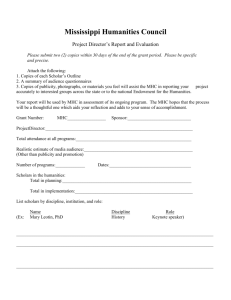Lynn Robertson Brent Tharp Christopher Cooper
advertisement
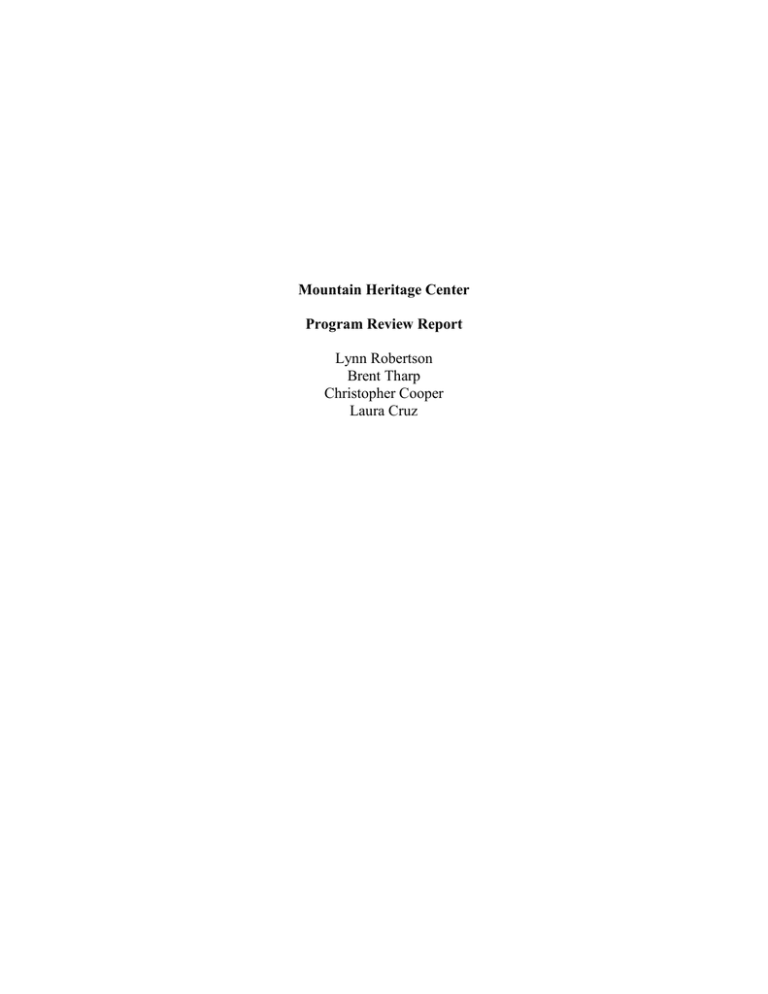
Mountain Heritage Center Program Review Report Lynn Robertson Brent Tharp Christopher Cooper Laura Cruz I. Introduction Program Review for the Mountain Heritage Center (MHC) took place on April 17-19, 2011. The Review Team consisted of two internal reviewers: • Dr. Christopher Cooper, Director, Public Policy Institute • Dr. Laura Cruz, Associate Director, Coulter Faculty Center and two external reviewers: • Ms. Lynn Robertson, Director, McKissick Museum, University of South Carolina • Dr. Brent Tharp, Director, Georgia Southern University Museum The Review Team completed a pre-visit conference call on April 9, 2011 followed by an organizational meeting on the evening of April 17. The on-site visit officially began on April 18 with an initial meeting with Linda Stanford, Interim Provost, Clifton Metcalf, Vice Chancellor for Advancement and External Affairs and Melissa Wargo, Asst. Vice Chancellor for Institutional Research, Effectiveness, and Planning. The day also included a meeting with University administrators Scott Higgins, Dean of the Graduate School and Carol Burton, Assistant Vice Chancellor for Undergraduate Studies. The Review team met separately with MHC Director Scott Philyaw and MHC Curator Pam Meister and toured the facilities including the exhibits and collections storage. Additional meetings that day included representative students who have worked with the Museum; MHC staff minus the Director and Curator; and Community Members including: • Tonya Carroll, Qualla Arts and Crafts • Lynn Hotaling, Sylva Herald • Emma Wertenburg, Appalachian Women’s Museum • Tim Osment, Cashiers Historical Society 1 The Review concluded on April 19 with an opportunity to meet with members of the MHC Faculty Advisory Committee including: • Mae Claxton, Department of English • Jane Eastman, Department of Anthropology and Sociology • Michael Despeaux, Career Services • Luther Jones, School of Stage and Screen • Arledge Armenaki, School of Stage and Screen and an exit meeting with, Metcalf, Philyaw, Meister, and Onder. The Review was well organized and the team felt that time allotted was sufficient, all pertinent stakeholders were well represented, and all documentation and requests for information were addressed in order to review the effectiveness, identify strengths, and make recommendations for the Mountain Heritage Center. II. Analysis of the Program The MHC has a clear and distinct mission that effectively guides the program. The mission to “collect, interpret, and disseminate knowledge about the southern Appalachian region and its people…” has grown naturally from the history of the University’s role and engagement in the area and is well linked to the University’s stated “commitment to the rich traditions of the Appalachian and Cherokee cultures” and goals of providing WCU students with significant applied learning, professional, and cultural enhancement opportunities. The professional and student staff members have a clear and consistent understanding of the MHC’s mission and functions and effectively communicate it. The mission and functions of the MHC are appropriate and relevant to students of WCU and to the public the University serves. All of the aspects of the 2 museum’s operations are represented in the current mission, which should provide a good foundation for the staff, advisory boards, and University administration to think strategically about the allocation of current and future resources, as well as the MHC’s management within the University structure. The activities of the museum including its collections, research, and programming support its mission. The collections, especially with the current review and deaccessioning in progress, are managed and well focused for the mission and functions of the MHC. Likewise, exhibits, research and programming are appropriate and well focused regionally. Importantly, with the small staff available, the MHC has made use of strengths within the faculty and community to create and present mission-appropriate exhibits and programming. Student involvement, class projects, and graduate student projects are relevant, professional experiences allowing students to work directly and creatively with exhibits, collections and programming. The activities and services of the MHC are responsive to the needs and interests of the local and student communities and coordinate an important interaction between the two. The MHC maintains an appropriate balance of academic and outreach efforts as stated in their mission. It will be important for the University administration to provide clear direction about the expected ratio of outreach and academics in the future to allow the MHC to responsibly plan and allocate resources. Efforts at planning and evaluation appear appropriate for the resources and staff time available. A Strategic Planning Retreat was held in 2009 and staff participated in developing a SWOT Analysis in January-February 2011. Evaluation of programming is conducted in a variety of ways including visitation counts, Google surveys of outreach kits, written evaluations and surveys and other more anecdotal methods. Evaluation is a staff-wide process of gathering and 3 evaluating information. Likewise, the MHC has effectively developed various advisory groups representing faculty and community members to assist in planning and assessing that ensures a wider perspective is incorporated in the process. In keeping with their mission as a University Museum, the MHC has also collaborated with a University Hospitality/Tourism class to develop and conduct vendor/attendee surveys for the Mountain Heritage Festival. The Review Team noted that there does not seem to be an effective way for graduate students in the Public History program to provide evaluation and feedback about their experiences. Those we met with were unanimously highly satisfied with their experiences and were eager to provide that feedback and interested in providing suggestions for future delineation/prioritization of tasks. III. Analysis of Staff a. Qualifications The MHC has three permanent professional museum positions: Director, Curator, and Education Associate. In addition there is a full time administrative office manager. (The Mountain Heritage Day coordinator is currently on extended sick leave and was not available for the site visit to the Center.)The position of curatorial specialist has been discontinued due to funding termination and that of the coordinator for the Digital Heritage Project is currently vacant. However, three part time retired faculty also supports the staff and the work of the Center, especially the digital component. The permanent staff of the center is exceedingly well qualified for their positions. Each has multiple years of academic and/or museum training and experience. The director, Dr. Scott Philyaw, in addition to a distinguished teaching and research career, has participated in the Museum of Early Southern Decorative Arts (Winston-Salem, NC) residence program and has 4 been recognized for excellence in interpretation by the National Park Service. Though not formally trained in museum studies he is well acquainted with the current standards in reference to the policies and best practices of museum work. He also maintains a demanding teaching schedule with all of the associated necessity for carrying forward his research and academic service role. Ms. Pamela Meister (Curator) comes to the Center with thirty years of professional experience in museum and arts management as well as academic training. She has a distinguished record in curatorial practices as well as administration. Mr. Peter Koch (educator) has a graduate degree in Public History as well as previous professional work experience at the North Carolina Museum of History and Historic Oak View Park (both Raleigh, NC) and extensive training and experience in first person interpretation. Ms. Norton (office manager) has more than 25 years of experience in this and similar positions and received a BS summa cum laude from Western Carolina University. The three former faculty members currently working part-time on the digital heritage initiative, Drs. Wood, Blethen, and Smith, bring excellent academic and professional expertise to the Center. Each has extensive experience in a museum setting with exhibition development or interpretation. The graduate and undergraduate students who work for the MHC are treated as paraprofessionals with stated duties and a written work plan. They provide an important function in staffing the Center as well as receive valuable experience that will further their career goals once they leave WCU. In summary, this unit’s staff has an outstanding combination of academic expertise, professional museum training and experience, and community engagement. The fact that they come to the Center’s mission with different experiences means that they mesh effectively together to make a well-qualified and working whole. b. Resources and Support 5 The staff at the Center originates and presents a large number of programs on a broad range of subjects each year. In addition, they are charged with maintaining a sizable and important collection of museum quality artifacts and extensive archival collections. The permanent positions at the MHC are appropriately structured to carry out these tasks. As permanent University employees they participate in the established procedures for evaluation and salary compensation. Each person is fully aware of the duties and responsibilities for their position. They have also taken on additional work where needed by the unit. There is also a healthy dayto-day system of informal evaluative “feedback” and a dedicated work ethic among the current staff. While the review team does not feel we are in a position to evaluate the compensation for individual staff, we do commend the staff for their excellent work and encourage the University to reward each appropriately when funds become available in the near future. The work at the Mountain Heritage Center requires the support of the University’s technological services not only to communicate to their constituencies both on and off campus, but also to maintain and upgrade the collections data base and develop object and archival programs including the Digital Heritage Project. The exhibitions currently include the presentation of information and supplementary images on computers accessible to visitors. Technological support from WCU has allowed the MHC to develop digital collaborative projects including two with the Hunter Library, “Horace Kephart: Revealing an Enigma” and “Craft Revival: Shaping Western North Carolina Past and Present.” It has also allowed the Center to provide a wireless network in its public spaces. This access to adequate technological resources has been, and will continue to be, an important resource. c. Professional Activity 6 The level of professional activity undertaken by the full time staff is exceptional. Each is heavily involved in both on and off campus service. In terms of the larger museum and cultural world, the staff have been active in presenting papers at conferences, teaching museum practices, serving on professional boards, and providing community leadership. Dr. Philyaw has shared his historical expertise through the presentation of research papers. For example, in 2008 he was asked to deliver the keynote address at the MESDA conference on backcountry culture. Ms. Meister has a long history of serving in numerous capacities with the Southeastern Museums Conference and the American Association of Museums among other museum organizations. She was one of the founding faculty members of the SEMC Jekyll Island (GA) Management Institute (a joint program between the Atlanta History center and West Georgia University). She is acknowledged to be one of the leaders in museum administration and training in the southeastern United States. Mr. Koch maintains an active schedule outside of his Center duties in working with scouting programs and other youth activities. In this way, staff members demonstrate that they take full advantage of opportunities for professional development beyond the University. Each is highly regarded by their peers for their contributions to both the museum and the educational fields. The MHC staff also makes considerable professional contributions to Western Carolina University. Dr. Philyaw continues to teach a significant academic load of classes as did Ms. Osborne before leaving the MHC. During the 2010 academic year Philyaw or Jones taught (or team-taught) seven academic courses. The staff also participates in University service through student internships, assistantships, and general mentoring of both graduates and undergraduates. They assist faculty with research and project development activities and partner with numerous 7 departments across campus. Our meetings indicate that they are respected by WCU faculty and staff. IV Operational Facilities and Budget a. Facilities The Mountain Heritage Center occupies the ground floor of the H. F. Robinson Administration building. This imposing structure is the first building one sees when entering campus. This allows the Center to proudly say it is at the very front door of the University. Although the location has advantages, the current square footage allotted to the Center is very constraining. The extensive object and archival collections are well cared for, but the storage rooms are small and curators have had to devise imaginative ways to accommodate all items. Even with the current plans to deaccession duplicate and less desirable items, the collections need additional storage and processing space. With the expansion of their activities with students and faculty and other additional campus programming, there is an increased need for work and research accommodations. The exhibitions are well researched and designed. While the amount of space dedicated to exhibitions is adequate, the configuration of that space makes designing presentations difficult. It would be to the University’s advantage to make the gallery space more flexible and increase both interior and exterior directional signage. The office spaces are adequate and well maintained by the staff. b. Budget The budget for the Mountain Heritage Center during fiscal year 2009-2010 was $222,043 with most salaries paid by Advancement and External Affairs. The Director position is paid by Academic Affairs and pro-rated to reflect academic responsibilities. The current year’s budget is 8 $278,238. Much of this increase is the result of fewer teaching responsibilities on the part of Center staff. At present the Center can maintain its core mission at this current level of state funding. The staff has plans to solicit external funding to enhance programming. Sponsorships and grants are being pursued to support the Mountain Heritage Days as well as other programmatic and collections initiatives. Unfortunately, outside support for staff positions is extremely hard to obtain. The MHC has wisely introduced the use of retired faculty to help in this area, however, this is not a final solution to the increased demands on current staff. There is the need for additional staff to direct digital initiatives and/or supplement collections management. It would be advisable for the University to consider adding an additional professional position when funding becomes available. V. Summary of Unit Strengths and areas for improvement a. What is your general impression of the unit? The review team found the Mountain Heritage Center to be a multi-faceted operation that serves both the needs of the campus and the community in ways that are innovative, effective, and appropriately focused on regional needs. In addition, the consensus of the review team was that the staff of the MHC was well-prepared to begin the national accreditation process as well as participate in the Museum Assessment Program offered through the American Association of Museums. b. Overall, what are the areas of strength? The review team identified four areas of strength for the Mountain Heritage Center. 1. Integration of the goals of the MHC with the mission of the University 9 The review team felt that one of the greatest strengths of the MHC was its integration with the mission of the University. a. Regional Engagement WCU is a regional comprehensive university with a clear commitment to serving the needs of the Western North Carolina region. In 2008, WCU received the Carnegie designation of engaged university in light of their success in integrating academic and community needs. More specifically, the University’s mission statement (approved in June, 2006), states that the institution provides “cultural opportunities” which focus on improving individual lives and enhancing “economic and community development in the region.” The MHC is one of the primary means by which the University meets its outreach and engagement mission. The MHC’s community partners consistently emphasized the collaborative role that the center plays in the larger community, particularly the immediate region around Sylva, Bryson City, and Cashiers. In addition to the collections and the exhibits, community partners highlighted the importance of educational outreach, community programs (such as the Thursday music series), Mountain Heritage Day, and community partnerships (such as the Appalachian Women’s Museum). Through the Digital Heritage Project, the MHC provides opportunities for cultural awareness that are available through the Digital Heritage website (digitalheritage.org), regular articles in the Sylva Herald, and daily radio broadcasts. The staff of the MHC have demonstrated their flexibility in realigning their programs to meet changing regional opportunities and constraints. Over the past two years, for example, the MHC has created several popular traveling exhibits and traveling educational trunks designed to bring the collections to different parts of the state, especially those affected by decreasing travel budgets for schools and other public entities. All educational outreach activities, including the 10 travelling trunks, are specifically keyed to areas within the North Carolina Standard Course of Study and are adapted as those standards are revised. b. UNC Tomorrow The UNC Tomorrow report asks member institutions to “promote the arts and cultural enrichment in all regions of the state” (UNC Tomorrow 4.4.4.). The MHC supports this outcome through a variety of programming and cultural activities. This outcome is most clearly supported by the 37th annual Mountain Heritage Day festival. Mountain Heritage Day is the university’s largest public event. It typically attracts over 20,000 visitors from throughout the region and has a significant impact on local hotels, restaurants, and other travel services. It also showcases local artists, performers, craftspeople, and vendors. Many of the stakeholders interviewed by the review team indicated that this event is synonymous with the MHC and WCU in the minds of many attendees. UNC Tomorrow also directs member institutions to “facilitate inclusive discussions on important community issues (UNC Tomorrow 4.4.5).” The MHC has offered programs and roundtable discussions on subjects as varied as endangered species, scientific and religious views of climate change, the role of women in mountain culture, and cemeteries on public lands. The collaboration with local news outlets has also strengthened its ability to facilitate community discussions. c. QEP The MHC Director, Scott Philyaw, is widely recognized for his integral role in developing WCU’s QEP. In response to QEP implementation, the MHC has intentionally increased its work with students. In addition to providing more tours, programs, and service learning opportunities for classes, they have increased individual student involvement in research 11 projects, exhibits, and publications. The MHC has greatly benefitted from the growth of the Public History program, led by Jessie Swigger in the History Department. In 2009, the MHC received a QEP assessment grant to assess how the Digital Heritage Project supports QEP outcomes. The results indicate that students and faculty both drew clear connections between the development and use of the DHP and the QEP, particularly the fifth outcome “clarify and act on purpose and values” which encourages students to integrate their DHP activities with future career goals. 2. Return on Investment The review team felt that the MHC staff have shown admirable abilities to produce a variety of high-quality exhibits, programs, and activities with limited budget and staff. This positive return in investment is apparent in comparison to museums across the country, as indicated by a 2002 census published by the American Association of Museusms: • Over 75% of the MHC’s FY10 operating expenses are devoted to museum-related activities. By comparison, 2002 museum census medians were 45% for history museums and 50% for museums with operating budgets within the same range as the MHC. • The MHC’s cost per visitor has dropped from $13.82 in 2008to only $7.58 in FY/2010. In the 2002 museum census, median costs per visitor was $18.83 for history museums and $17.39 for museums in with the same budget range as the MHC. The positive return on investment is also apparent in comparison to peer institutions in the region. 12 • In 2009, ASU’s Turchin Center for the Visual Arts, for example, had an operating budget of $496, 055 and visitation numbers of approximately 16,000 (approximately $31 per visitor). • In the same year, the museum at Georgia Southern posted an operating budget of $367,609 with 21,000 visitors (approximately $17.50 per visitor). • In comparison, the MHC had an operating budget of $220,043 with 30,553 visitors (approximately $7.50 per visitor). The MHC is also admirable in its ability to produce a wide range of programs, exhibits, and activities limited staff. • The Turchin Center operates with 4 full time, 3 part time, and 4 student staff members. • The GSU museum operates with 7 full-time, 13 part-time, and 20 volunteer staff members. • The MHC currently operates with 4 and ½ full time staff, three part-time staff, 4 students and 2 volunteers. Funding has been discontinued for two positions, Digital Heritage Project Coordinator (ends June 2011) and Curatorial Specialist (ended January 2011). From these comparisons, it is clear that the MHC represents appropriate value and return on investment that exceeds national and regional averages. 3. Outreach Though many of the strengths of the MHC’s outreach programs are detailed in 1a (above), the review team felt that outreach was also a stand-alone strength of the museum’s programs. Community partners were unequivocal in their support for the MHC and its role as a community center. For many community members, the MHC stands as a gateway between the 13 University and the region and that partnership begins with educational outreach in the elementary schools, an experience many members of the community remember fondly. For the members of the review team, the MHC’s educational outreach was clearly a highpoint. The MHC offers free, direct support for public, charter, and private schools in the area. In addition to in-school programming and travelling trunks, MHC staff members have presented programs for teaching training at the North Carolina Center for the Advancement of Teaching (NCAT), the North Carolina Museum of History, Mars Hill College, and WCU. The MHC is also making teacher resources generated by the now-discontinued Adventure of the American Mind project available through DigitalHeritage.org. Their work with local schools was praised as promoting positive university-community relationships by every group interviewed by the review team. 4. Collections The review team found that the collections, and collection management processes, represented a significant strength of the MHC. According to the American Association of Museums, one of the primary characteristics of an accreditable museum is collections stewardship, which includes the following: • The museum owns, exhibits, or uses collections that are appropriate to its mission The MHC possesses a rich collection of approximately 10,000 artifacts, largely donated by community members. The collection appropriately traverses the varied material culture of the western North Carolina region. As one of the first professional institutions to collect and document the daily life of Western North Carolina, the collections provide an unmatched resource for scholars, students and the general public. 14 • The museum legally, ethically, and effectively manages, documents, cares for, and uses the collections Under its current staff, the MHC has made great strides in its collection management, including the consistent identification of all items in the collection, performed through the adoption of PastPerfect and Nomenclature 3.0, the industry-standard software for museum cataloging, as well as the reorganization of the collection space to better locate and care for collection artifacts. The MHC has recently begun a significant de-accession project to streamline the collection and to create space for new objects. In this process, the staff have identified objects for deaccession that are redundant and/or do not serve the MHC’s mission. In conversations with the staff, it was clear that they were sensitive to the legal and ethical issues that often surround deaccession and that all efforts were being made to notify and discuss de-accession decisions with donors and foundation members. • The museum’s collections-related research is conducted according to appropriate scholarly standards. MHC staff members are active professionals who present at scholarly conferences and are active in professional organizations. Recent highlights include contributions to Haywood County: Portrait of a Mountain Community (2010, winner of the Willie Parker Peace History Book Award and the President’s Award from the North Carolina Society of Historians), and Nomenclature 3.0 for Museum Cataloging. • The museum strategically plans for the use and development of its collections. The MHC staff is currently in the process of revising their collection plan, but exhibits and other uses of items in the collection has already been planned for the 2010-11 academic year. 15 There is a great deal of interest in better utilizing the MHC’s extensive collection of oral history interviews, films, and musical performances, which are not currently part of the active catalogue/collection. Such artifacts, if digitized and indexed, could represent an original contribution to public knowledge of regional history. • Guided by its mission, the museum provides public access to its collections while ensuring their preservation. The items in the collection are displayed through three main galleries, two lobby display areas, and through travelling and digital exhibits (including the Digital Heritage Project). The physical exhibit spaces host rotating exhibits, the travelling exhibits are regularly updated, and new digital exhibits are being added annually. c. Overall, in what areas could the unit make improvements? The review team is very impressed with the MHC, but we do have some thoughts as to how the MHC could even better fulfill their mission. • We recommend that the MHC staff develop a formal procedure where by students could evaluate their experiences as well as the supervision they received from the MHC staff. • To help further integrate the mission of the MHC with Academic Affairs, the MHC might explore the possibility of having a dedicated area serve as a rotating “hands-on laboratory” space available to appropriate classes across the campus. • The MHC has a tremendous amount to offer the faculty, but some faculty are not aware of these resources. We encourage the MHC to reach out to new faculty (perhaps through new faculty orientation) and help them understand how they can integrate their teaching, research, and service with the MHC. 16 • The MHC seems to be fulfilling its mission well. To better document this excellent work, we encourage the MHC to work with the Office of Assessment to augment and improve the assessment of their programs. • We strongly encourage the university administration to work with the MHC to enhance both the interior and exterior signage at the MHC in order to direct visitors. In particular, perhaps the administration could see fit to place identifying signage at the main entrance of the building to attract greater visitation as well as welcome audiences. • We applaud the MHC for seeking out external funding and recommend that the MHC continue to commit resources to this important effort. It might even be possible for the MHC to work with grant-writing classes on campus (in Public Affairs or English) to reduce the workload on MHC staff. • Ultimately we would recommend that the MHC begin the process to seek accreditation by the American Association of Museums. AAM accreditation would bring national recognition to the museum for its commitment to excellence, accountability, high professional standards, and continued institutional improvement appropriate to its circumstances and resources. The process of self-study and long-term planning in cooperation with the community and administration would address the recommendations made in this report. Accreditation would require a significant amount of work, but this committee’s review did not indicate any major issues, at this time, that would preclude the MHC from achieving that goal. VI. Summary of Recommendations 17 In sum, all four members of the review team are deeply impressed with the work of the MHC. We commend the staff on their excellent work and strongly encourage them to continue moving in their current direction. We do hope they will consider some of the recommendations above and we urge the administration to ensure that the budget and staffing of the MHC increases when the financial situation improves. 18


